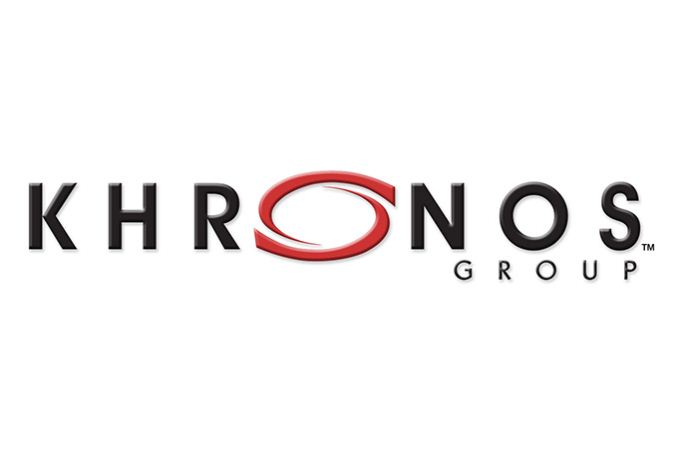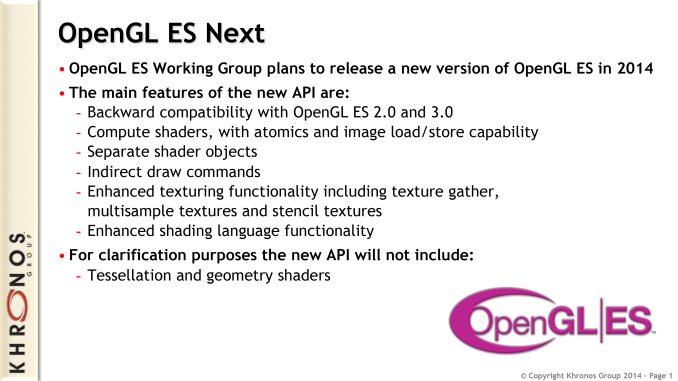Khronos Offers a Quick Peek at the Next Version of OpenGL ES
by Ryan Smith on January 8, 2014 11:00 AM EST
Amidst the hustle and bustle of CES 2014, Khronos has published a short announcement regarding the next version of OpenGL ES (OpenGL ES Next). In it they are offering a brief high level overview of their plans for their mobile graphics API.
In short, Khronos is announcing that they will be releasing OpenGL ES Next this year, which would put it roughly 2 years after the release of OpenGL ES 3.0. As is expected it will come with several new features – many of these being brought over in some form from mainline OpenGL – while at the same time continuing to walk the narrow line between being a separate API and a pure subset of OpenGL.
Feature wise, OpenGL ES Next will bring with it support for a number of features that were introduced in OpenGL 4.x. This includes compute shaders (OGL 4.3), shader atomics with load/store capabilities (OGL 4.2), indirect draw commands (OGL 4.0), texture multi-sampling (OGL 3.2). All of these features will be important additions to the API for different reasons, be it increasing the capabilities and performance of the shader system, or further adding onto the functionality of the texturing system. The addition of compute shaders will likely be the marquee feature for OpenGL ES Next, but that shouldn’t discount the importance of the other feature additions.
Meanwhile Khronos has also offered a brief glimpse of what they won’t be including, in order to better illustrate where they’re going with OpenGL ES Next and how it compares to other APIs. OpenGL ES Next will not be including some of OpenGL’s high-end geometry functionality, specifically geometry shaders (OGL 3.2) and tessellation (OGL 4.0). Just as how OpenGL ES 3.0 isn’t quite at feature parity with OpenGL 3, these omissions mean that OpenGL ES Next will still have some significant differences compared to OpenGL 4, and even OpenGL 3 again. In other words, just as how OpenGL ES 3.0 was in many ways a reduced scope version of OpenGL 3, OpenGL ES Next will continue that trend by being a reduced scope version of OpenGL 4.
Wrapping things up, with a publication date set for this year, it’s a solid bet that we should hear more about OpenGL ES Next towards the middle of this summer. Khronos’s major announcements typically come around SIGGRAPH (Aug. 10-14, 2014), with OpenGL ES 3.0 and OpenGL 4.4 being announced at that show in previous years, so that’s where we’d expect Khronos to announce at least a preliminary draft of Open GL Next, if not the final version.
Special thanks to our own Rahul Garg for catching this announcement
Source: Khronos











19 Comments
View All Comments
da_asmodai - Wednesday, January 8, 2014 - link
I'm not sure what other industries use OpenGL ES but I suspect there is little need for a post 3.0 version in the smartphone/tablet space. Companies seem to be adding full OpenGL/DirectX support to there GPUs as the next step instead.mczak - Wednesday, January 8, 2014 - link
I don't think that's quite true. Series 6 from powervr for instance have tesselation as an optional feature, and I believe none of the shipping or shipping soon SOCs using series 6 have it.But you are obviously right for the IHVs which derive their smartphone/tablet gpu IP from larger chips (intel with bay trail, amd with temash already did this, and now nvidia starting with Tegra 5 too). Qualcomm is also rumored to have tesselation though with Adreno 4xx (and it's not derived from a larger chip). I don't know anything about the other graphic cores floating around (Vivante etc.) but wouldn't be surprised if there's others which can't do tesselation. And I suspect some of the existing ones (like Adreno 3xx) possibly could already do everything required by GLES 4.0 or whatever it's called (I know that some should be able to do some of the new features though I don't really know if they could do all of them).
da_asmodai - Wednesday, January 8, 2014 - link
PowerVR Series 6 from Imagination Technologies support full OpenGL 3.2 and DirectX 10 according to the Wikipedia and they're in products (iPhone) now. OpenGL ES Next isn't even released yet and once released will likely be over a year before products implement it. You don't think by then PowerVR Series 7 won't be out? You don't think they'll add support for OpenGL 4+ to compete with Tegra K1 by then? The Adreno 420 also claims DirectX 11.1 support though I haven't seen a specific OpenGL version assigned. It does however have tessellation hardware. Again though the point is this standard hasn't even be finalized and then it will take time to actually get to market. It won't even match OpenGL 3.0 (NOT ES) and there is already OpenGL 3+ hardware in phones and there will be even more capable GPUs on mobile before this ES Next hits the streets. So sure, you may be able to retroactively say your obsolete hardware (Adreno 3xx for example) support ES Next but who cares?Krysto - Wednesday, January 8, 2014 - link
Wrong again. Imagination will keep Series6 for at least 4-5 years before releasing a new GPU architecture, just like they did for Series5. ARM will do the same with Midgard.That doesn't mean they couldn't try to support the full OpenGL, but it will be faster for them to just wait for OpenGL ES Next, than try and port OpenGL 4.4 or 4.5, which will come out next year, I bet. Even Intel doesn't support more than 4.0 in Haswell, and they barely got that ready, too. I remember saying even here on Anandtech about a year ago how disappointed I was Intel will only come out with OpenGL 3.2 for Haswell. They adopted 4.0 at the last minute. I don't think even Broadwell will support more than 4.2. As for the open source versions of their own drivers, Intel is still only up to 3.3.
So the bottom line is it's very time consuming to support the full OpenGL. Nvidia took a shortcut by porting its PC architecture, which already supported OpenGL 4.4, and has always been up to date with OpenGL support, to mobile. That's why the others will remain so far behind for years. Their only hope to catch up (mostly) is OpenGL ES Next, but they won't do it until 2016, and even that is a little earlier than it would've happened without Nvidia doing what they did. I would've expected them to move to ES 4.0 or whatever in 2017.
da_asmodai - Wednesday, January 8, 2014 - link
So they'll keep calling it Series 6 but they'll keep adding capabilities and Series 6 will span APIs. What they call it really isn't important. The point is that we're at ES 3 now and full OpenGL 3.x seems to be where things are going. I didn't say mobile was going to keep up with the latest and greatest OpenGL specs so yeah maybe OpenGL 4.5 will be out but mobile devices will be supporting only OpenGL 3.2 (which Series 6 has models that already claim to do.) The article specifically states that GL Next will NOT include Geometry shaders and tesselation but mobile hardware is already shipping with these things so leaving them out is not where the industry is going. Now maybe budget phones will support ES Next but top tier phones a year from now are more likely to support full OpenGL 3.2+ then ES Next.tuxRoller - Wednesday, January 8, 2014 - link
The GPU makers could adopt the gallium model so they "only" have to implement hardware enablement for each generation and have a device independent shared ogl/es library.That, of course, would require companies to work together but, in practice, it's the same incentive as moving kernel code upstream.
mczak - Wednesday, January 8, 2014 - link
As I said, PowerVR Series 6 chips can do tesselation (which is a DX11 feature btw, not 10) _optionally_. FWIW I don't think Series 7 is around the corner, powervr just announced some updated Series 6 (6 XT) which have the same feature set (just to get some idea for the timeline a series may stay around, series 5 was the current one for like 8 years, though 5XT was a significant upgrade, and actually some parts of series 5 but definitely not all were already dx10 compliant though I don't know of any such shipping configuration outside of intel's atom platform).If you look at all the Series 6 parts, some are dx10 compliant, some ought to be dx11 compliant, and some only even support feature level 9_3. And I don't think that those shipping (or shipping soon) really could do tesselation - though it's actually very difficult to tell.
dragonsqrrl - Wednesday, January 8, 2014 - link
Just because a GPU supports tessellation doesn't necessarily mean it's DX11 compliant. Tessellation is not a DX11 exclusive feature. AMD included a proprietary tessellator in their HD2000 - HD4000 series cards (that no one ever used), all of which were limited to DX10 or 10.1 compliance.dragonsqrrl - Wednesday, January 8, 2014 - link
Ya, Series 6 is going to be around for a while.http://www.anandtech.com/show/7629/imagination-tec...
According to this article Series 6XT, which is very similar architecturally to the currently shipping series 6, won't come to market before 2015, likely 2H 2015. This means that Imagination Tech probably won't be at the same level of API compliance as Nvidia and Qualcomm in 2014 and 1H 2015. Not that I think being limited to DX10, OpenGL 3.2, and ES 3.0 until 2H 2015 is a huge deal, but to answer your question:
"You don't think by then PowerVR Series 7 won't be out? You don't think they'll add support for OpenGL 4+ to compete with Tegra K1 by then? "
... not necessarily.
melgross - Wednesday, January 8, 2014 - link
I can't really agree. While I can't speak well to the android market, the iOS market has a number of CAD apps from well known makers, some of which I use. There are other apps which make use of open GL as well. The more incorporated features the better. These programs, whether on a "classic" OS X or Windows machine, or on iOS,don't normally use directX, which is really intended for gaming, so advances there aren't directly usable, unless OpenGL incorporates a few of the features from that.